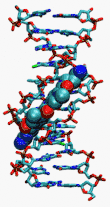Netropsin
Netropsin ist ein Polyamid-Antibiotikum, das an die kleine Furche einer DNA-Doppelhelix bindet.[2] Es wirkt gegen Gram-positive und Gram-negative Bakterien.[3]
| Strukturformel | |||||||||||||||||||
|---|---|---|---|---|---|---|---|---|---|---|---|---|---|---|---|---|---|---|---|
 | |||||||||||||||||||
| Allgemeines | |||||||||||||||||||
| Name | Netropsin | ||||||||||||||||||
| Andere Namen |
| ||||||||||||||||||
| Summenformel | C18H26N10O3 · 2HCl | ||||||||||||||||||
| Kurzbeschreibung |
gelber Feststoff[1] | ||||||||||||||||||
| Externe Identifikatoren/Datenbanken | |||||||||||||||||||
| |||||||||||||||||||
| Eigenschaften | |||||||||||||||||||
| Molare Masse | 503,39 g·mol−1 | ||||||||||||||||||
| Aggregatzustand |
fest[1] | ||||||||||||||||||
| Schmelzpunkt | |||||||||||||||||||
| Sicherheitshinweise | |||||||||||||||||||
| |||||||||||||||||||
| Soweit möglich und gebräuchlich, werden SI-Einheiten verwendet. Wenn nicht anders vermerkt, gelten die angegebenen Daten bei Standardbedingungen. | |||||||||||||||||||
Eigenschaften

Netropsin wurde erstmals 1951 durch A. C. Finlay beschrieben, der es aus dem Actinobakterium Streptomyces netropsis isoliert hatte.[4] Netropsin gehört zur Klasse Pyrrol-Amidin-Antibiotika und ist ein Analogon von Distamycin und den Lexitropsinen. Es bindet bevorzugt AT-reiche DNA-Sequenzen doppelsträngiger DNA und Tetraden aus [TGGGGT]4,[5][6][7] nicht jedoch an einzelsträngige DNA oder RNA. Die Bindung von Netropsin führt zu einer engeren Windung von etwa 9° pro gebundenem Lexitropsin und Basenpaar.[8][9] Bei einer positiven Superspiralisierung entspannt es daher die DNA, während es eine negative Superspiralisierung verstärkt.[10] Der Bindungsmechanismus ist noch nicht vollständig geklärt.[11] Verschiedene Distamycin-Derivate wurden entwickelt, um als Alkylanzien gegen Tumoren eingesetzt zu werden oder zur Fluoreszenzmarkierung von doppelsträngiger DNA.[12][13][14]
Einzelnachweise
- Datenblatt Netropsin dihydrochloride bei Sigma-Aldrich, abgerufen am 24. November 2013 (PDF).
- M. P. Barrett, C. G. Gemmell, C. J. Suckling: Minor groove binders as anti-infective agents. In: Pharmacology & Therapeutics. Band 139, Nummer 1, Juli 2013, S. 12–23, doi:10.1016/j.pharmthera.2013.03.002. PMID 23507040.
- C. Zimmer, U. Wähnert: Nonintercalating DNA-binding ligands: specificity of the interaction and their use as tools in biophysical, biochemical and biological investigations of the genetic material. In: Progress in biophysics and molecular biology. Band 47, Nummer 1, 1986, S. 31–112, PMID 2422697.
- A.C. Finlay, F. A. Hochstein, B. A. Sobin, and F. X. Murphy, J. Am. Chem. Soc. 73 341–343 (1951). doi:10.1021/ja01145a113.
- M. L. Kopka, C. Yoon, D. Goodsell, P. Pjura, and R.E. Dickerson, J. Mol. Biol. 183 553–563 (1985)
- M. L. Kopka, C. Yoon, D. Goodsell, P. Pjura, R. E. Dickerson: The molecular origin of DNA-drug specificity in netropsin and distamycin. In: Proceedings of the National Academy of Sciences of the United States of America. Band 82, Nummer 5, März 1985, S. 1376–1380, PMID 2983343. PMC 397264 (freier Volltext).
- B. Pagano, I. Fotticchia, S. De Tito, C. A. Mattia, L. Mayol, E. Novellino, A. Randazzo, C. Giancola: Selective Binding of Distamycin A Derivative to G-Quadruplex Structure [d(TGGGGT)](4). In: Journal of nucleic acids. Band 2010, 2010, S. , doi:10.4061/2010/247137. PMID 20725616. PMC 2915651 (freier Volltext).
- G. Snounou and A. D. B. Malcolm, J. Mol. Biol. 167 211–216 (1983)
- H. Triebel, H. Bär, R. Geuther, and G. Burckhardt, Progr. Colloid. Polym. Sci. 99 45–54 (1995).
- J. Lipfert, S. Klijnhout, N. H. Dekker: Torsional sensing of small-molecule binding using magnetic tweezers. In: Nucleic Acids Research. Band 38, Nummer 20, November 2010, S. 7122–7132, doi:10.1093/nar/gkq598. PMID 20624816. PMC 2978369 (freier Volltext).
- Y. Y. Fang, V. R. Morris, G. M. Lingani, E. C. Long, W. M. Southerland: Genome-Targeted Drug Design: Understanding the Netropsin-DNA Interaction. In: The open conference proceedings journal. Band 1, 2010, S. 157–163, PMID 21297883. PMC 3032215 (freier Volltext).
- G. S. Khan, A. Shah, Zia-ur-Rehman, D. Ba: Chemistry of DNA minor groove binding agents. In: Journal of photochemistry and photobiology. B, Biology. Band 115, Oktober 2012, S. 105–118, doi:10.1016/j.jphotobiol.2012.07.003. PMID 22857824.
- C. Bailly, J. B. Chaires: Sequence-specific DNA minor groove binders. Design and synthesis of netropsin and distamycin analogues. In: Bioconjugate Chemistry. Band 9, Nummer 5, 1998 Sep-Oct, S. 513–538, doi:10.1021/bc980008m. PMID 9736486.
- T. Vaijayanthi, T. Bando, G. N. Pandian, H. Sugiyama: Progress and prospects of pyrrole-imidazole polyamide-fluorophore conjugates as sequence-selective DNA probes. In: ChemBioChem Band 13, Nummer 15, Oktober 2012, S. 2170–2185, doi:10.1002/cbic.201200451. PMID 23023993.
